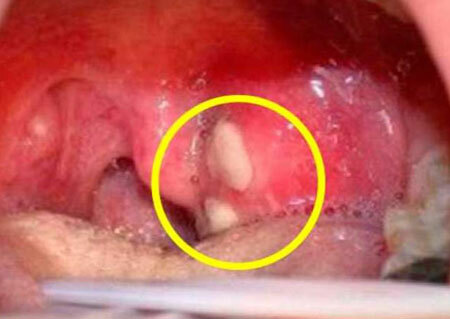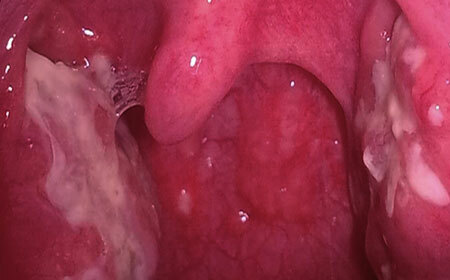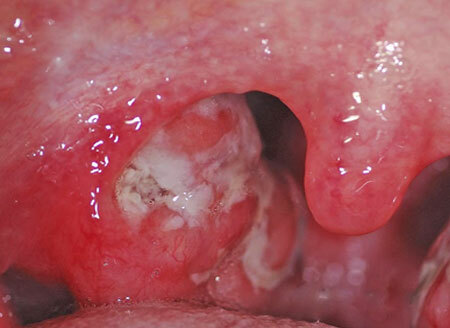Purulent angina is a severe inflammation of the palatine tonsils, which is characterized by the appearance on the hyperemic surface of the islets of yellow-white raids. They can merge( photo), but do not go beyond the lymphoid tissue. The disease is bilateral, but the degree of damage varies. Duration of treatment is from three to seven or more days.
Contents of
- 1 Purulent sore throat: what is it?
- 2 Kinds of purulent sore throat
- 3 Causes of purulent sore throat
- 4 Symptoms of purulent sore throat, photo
- 5 Purulent angina in the child - features of symptomatology
- 6 Treatment of purulent sore throat in children and adults
- 6.1 Complications of
- 6.2 Purulent angina and pregnancy
- 7 Prevention measures
Purulent sore throat: whatis this?

photos of purulent sore throat
The peculiarity of purulent involvement of palatine tonsils - deep changes in the parenchyma, leukocyte infiltrates appear with the formation of tissue necrosis. The accumulation of leukocytes in lacunae - is called lacunar angina, in the parenchyma - follicular.
Plots of suppuration are well defined in a visual examination. They look like white granules or accumulate in lacunae.
Pathogens - cocci, yeast fungi, bacteria - sticks and spirochetes. Acute tonsillitis is most affected by children and adolescents. Purulent sore throat in adults occurs rarely.
Infection with sore throat can be by airborne droplets or through general household items. Most often the disease manifests itself in the autumn and spring period.
Types of Purulent Sore Throat
Specialists subdivide purulent tonsillitis into two types:

photos of purulent sore throat in adults
Lacunar angina. In this case lacunae of the tonsils are affected, however, the process does not go beyond them. The purulent deposit is easily removed, the wounds after that do not bleed.
Follicular sore throat. More complex form, amygdala follicles are affected, pus is not easily removed, purulent abscesses can occur.

Purulent islets, photo 3
They relate to banal types of angina, occur after the introduction of the microbe and are determined by pharyngoscopy. The catarrhal form precedes the development of a purulent form.
Causes of purulent sore throat
Causes of purulent sore throat are divided into three groups according to the previous factors:
- Episodic - arising on the background of worsening of weather conditions;
- Epidemic - transmitted from the patient;
- Exacerbation of chronic inflammation of the tonsils( tonsillitis).
The main cause of the disease is streptococcal infection. However, there are certain factors that can also provoke the development of acute tonsillitis. For example:
- Weakened immunity;
- Subcooling of the whole organism and throat in particular;
- Sharp change in ambient temperature;
- Stay in the smoked room for a long time;
- Traumatic injuries of the tonsils;Diseases of the oral cavity, such as caries or stomatitis;
- Alcohol abuse.
Purulent tonsillitis often occurs in areas with very polluted air. Therefore, people in cities suffer from angina more often than in rural areas.
Symptoms of purulent sore throat, photo

The main symptoms of purulent sore throat begin to appear in a person about 5-7 days after infection. You can not miss them:
- Chills, joint aches, headache;
- With purulent angina, the temperature rises rapidly and can reach 39-40 degrees;
- Sore throat, especially when eating and swallowing saliva;
- On examination, you can see enlarged tonsils and a yellow-gray coating on them;
- Lymph nodes are enlarged, touching them is painful;
- Missing appetite, may cause nausea, vomiting, constipation.
These are the main symptoms of acute tonsillitis, but in every person this disease can occur with some other characteristics.
Purulent angina in the child - features of the symptomatology
Purulent angina in children is always difficult. It must be treated immediately. At the first stage, the child has general weakness, discomfort in the throat, which then turns into a strong painful sensation. The temperature rises sharply, there may appear a runny nose, cough, headache.
In children, purulent angina occurs with a predominance of general symptoms, an increase in lymph nodes, severe intoxication, vomiting and convulsions.
Such a disease in a child can not be left untreated, otherwise very unpleasant complications may occur in the form of sepsis, cardiac dysfunction, rheumatism, kidney problems.
To make an accurate diagnosis, doctors use the following methods:
- Patient survey;
- Visual inspection of the patient's mouth, temperature measurement;
- If necessary, a specialist can assign some tests. For example, to establish a more accurate cause of the disease( smear of pharynx).
Treatment of purulent sore throat in children and adults

In case of symptoms of purulent sore throat, a child should always consult a doctor. To leave the disease without attention is by no means impossible to adults or children.
Treatment of purulent sore throat in the home is possible and includes a set of specific measures:
- Bed rest will help the body to cope with the disease more quickly. Food all the better to grind, so as not to irritate the sore throat.
- Abundant warm drink, especially at a temperature.
- Antibiotics for purulent sore throat are mandatory. This will help to cope faster with pathogens( appoint a doctor!).
- At home, you can use special antibacterial drugs for irrigation of the throat and patients with tonsils.
- It is necessary to gargle with a purulent sore throat. For these purposes, decoctions of medicinal herbs, a solution of soda or salt are used. All this should be warm, but not hot. Rinses very well help to clear an oral cavity of a purulent deposit and possess disinfecting properties.
- Do not forget medicines to reduce body temperature( paracetamol, ibuprofen).
- When taking antibiotics, the work of the intestine is disrupted, so they take preparations that restore the intestinal flora.
- It is necessary to use in the treatment of vitamin complexes and drugs that strengthen immunity.
If home treatment does not produce the necessary results, especially in children, hospitalization in the hospital is possible.
Complications of
If you treat the disease lightly and do not treat it according to all the rules, it can lead to the development of complications.
To such consequences carry:
- Diseases of ears and nasal sinuses, problems with breathing;
- Meningitis;
- Diseases of joints and bones;
- Infection of the blood;
- Heart Dysfunction;
- Problems with the kidneys.
It should be remembered that any complication after a purulent sore throat arises as a result of poor-quality treatment. Therefore, it is necessary to fulfill all the prescriptions of doctors.
Purulent sore throat and pregnancy
During pregnancy, the woman's immunity is slightly weakened, so she is easily exposed to various diseases. Angina is no exception. This disease is dangerous for both the child and the mother. Especially a sharp rise in temperature.
Special drugs are used for treatment, which do not harm a woman and a baby. However, the whole process should be supervised by specialists so that there are no side effects.
Preventive measures
To avoid purulent sore throat, it is necessary to carry out restorative measures: spend more time in the fresh air, temper, avoid hypothermia.
Compliance with the drinking regime( drinking at least 2 liters of water a day) will help cleanse the body, rejection of bad habits will allow to strengthen immunity sufficiently to not get sick with angina in the cold season. Avoid contact with patients.
Purulent sore throat is a common, hard-working disease, but treatable with all the recommendations of specialists.



